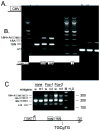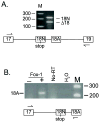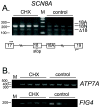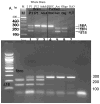Rbfox proteins regulate alternative splicing of neuronal sodium channel SCN8A
- PMID: 22044765
- PMCID: PMC3278527
- DOI: 10.1016/j.mcn.2011.10.005
Rbfox proteins regulate alternative splicing of neuronal sodium channel SCN8A
Abstract
The SCN8A gene encodes the voltage-gated sodium channel Na(v)1.6, a major channel in neurons of the CNS and PNS. SCN8A contains two alternative exons,18N and 18A, that exhibit tissue specific splicing. In brain, the major SCN8A transcript contains exon 18A and encodes the full-length sodium channel. In other tissues, the major transcript contains exon 18N and encodes a truncated protein, due to the presence of an in-frame stop codon. Selection of exon 18A is therefore essential for generation of a functional channel protein, but the proteins involved in this selection have not been identified. Using a 2.6 kb Scn8a minigene containing exons 18N and 18A, we demonstrate that co-transfection with Fox-1 or Fox-2 initiates inclusion of exon 18A. This effect is dependent on the consensus Fox binding site located 28 bp downstream of exon 18A. We examined the alternative splicing of human SCN8A and found that the postnatal switch to exon 18A is completed later than 10 months of age. In purified cell populations, transcripts containing exon 18A predominate in neurons but are not present in oligodendrocytes or astrocytes. Transcripts containing exon 18N appear to be degraded by nonsense-mediated decay in HEK cells. Our data indicate that RBFOX proteins contribute to the cell-specific expression of Na(v)1.6 channels in mature neurons.
Copyright © 2011 Elsevier Inc. All rights reserved.
Figures






Similar articles
-
Developmental dynamics of voltage-gated sodium channel isoform expression in the human and mouse brain.Genome Med. 2021 Aug 23;13(1):135. doi: 10.1186/s13073-021-00949-0. Genome Med. 2021. PMID: 34425903 Free PMC article.
-
Alternative splicing of the sodium channel SCN8A predicts a truncated two-domain protein in fetal brain and non-neuronal cells.J Biol Chem. 1997 Sep 19;272(38):24008-15. doi: 10.1074/jbc.272.38.24008. J Biol Chem. 1997. PMID: 9295353
-
Mutually exclusive splicing regulates the Nav 1.6 sodium channel function through a combinatorial mechanism that involves three distinct splicing regulatory elements and their ligands.Nucleic Acids Res. 2012 Jul;40(13):6255-69. doi: 10.1093/nar/gks249. Epub 2012 Mar 19. Nucleic Acids Res. 2012. Retraction in: Nucleic Acids Res. 2024 Jan 11;52(1):509. doi: 10.1093/nar/gkad1123. PMID: 22434879 Free PMC article. Retracted.
-
Sodium channels and neurological disease: insights from Scn8a mutations in the mouse.Neuroscientist. 2001 Apr;7(2):136-45. doi: 10.1177/107385840100700208. Neuroscientist. 2001. PMID: 11496924 Review.
-
Allelic mutations of the sodium channel SCN8A reveal multiple cellular and physiological functions.Genetica. 2004 Sep;122(1):37-45. doi: 10.1007/s10709-004-1441-9. Genetica. 2004. PMID: 15619959 Review.
Cited by
-
Developmental dynamics of voltage-gated sodium channel isoform expression in the human and mouse brain.Genome Med. 2021 Aug 23;13(1):135. doi: 10.1186/s13073-021-00949-0. Genome Med. 2021. PMID: 34425903 Free PMC article.
-
Sodium channelopathies in neurodevelopmental disorders.Nat Rev Neurosci. 2021 Mar;22(3):152-166. doi: 10.1038/s41583-020-00418-4. Epub 2021 Feb 2. Nat Rev Neurosci. 2021. PMID: 33531663 Free PMC article. Review.
-
Rbfox1 regulates alternative splicing of Nrcam in primary sensory neurons to mediate peripheral nerve injury-induced neuropathic pain.Neurotherapeutics. 2024 Jan;21(1):e00309. doi: 10.1016/j.neurot.2023.e00309. Epub 2023 Dec 19. Neurotherapeutics. 2024. PMID: 38241164 Free PMC article.
-
In vitro analysis of splice site mutations in the CLCN1 gene using the minigene assay.Mol Biol Rep. 2014 May;41(5):2865-74. doi: 10.1007/s11033-014-3142-5. Epub 2014 Jan 23. Mol Biol Rep. 2014. PMID: 24452722
-
Characterization of Na+ currents regulating intrinsic excitability of optic tectal neurons.Life Sci Alliance. 2023 Nov 2;7(1):e202302232. doi: 10.26508/lsa.202302232. Print 2024 Jan. Life Sci Alliance. 2023. PMID: 37918964 Free PMC article.
References
-
- ASSP splice predictor. http://www.es.embnet.org/~mwang/assp.html.
-
- Barres BA, Hart IK, Coles HS, Burne JF, Voyvodic JT, Richardson WD, Raff MC. Cell death and control of cell survival in the oligodendrocyte lineage. Cell. 1992;70:31–46. - PubMed
-
- Barres BA, Koroshetz WJ, Chun LL, Corey DP. Ion channel expression by white matter glia: the type-1 astrocyte. Neuron. 1990;5:527–544. - PubMed
-
- Barres BA, Silverstein BE, Corey DP, Chun LL. Immunological, morphological, and electrophysiological variation among retinal ganglion cells purified by panning. Neuron. 1988;1:791–803. - PubMed
Publication types
MeSH terms
Substances
Grants and funding
LinkOut - more resources
Full Text Sources
Other Literature Sources
Molecular Biology Databases
Miscellaneous

